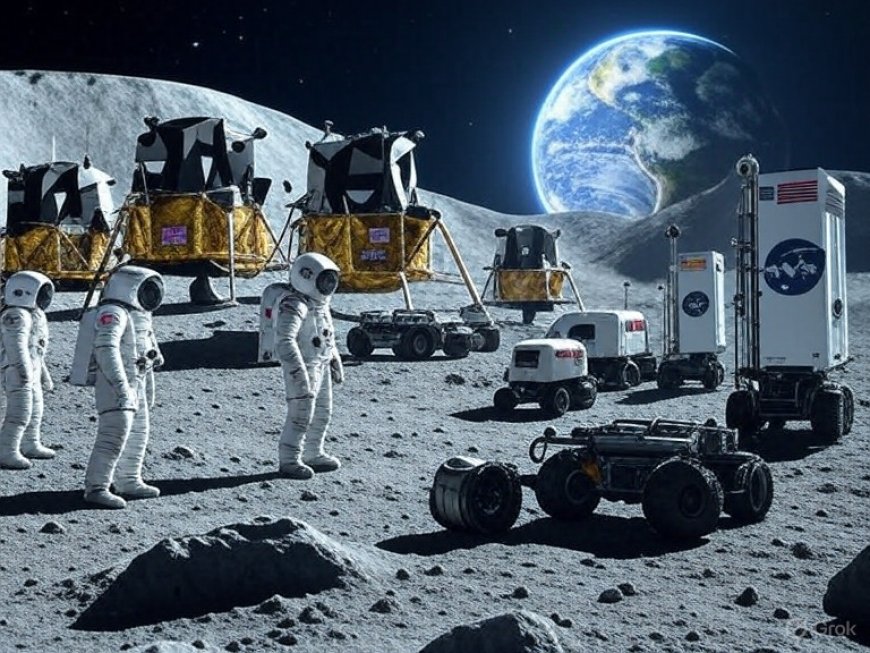The U.S. Push to Mine the Moon: How NASA and Private Firms Are Racing for Lunar Resources
NASA and private U.S. companies are racing to mine the Moon, competing for water ice, helium-3, and rare earth resources that could redefine space exploration and global power.

Washington, D.C., August 17, 2025 — The United States is accelerating its race to secure a foothold on the Moon, not just for exploration but for extracting and utilizing resources that could reshape the future of space travel and global power dynamics. With NASA’s Artemis program already paving the way for astronauts to return to the lunar surface, a new frontier is opening: mining the Moon.
From Exploration to Extraction
The Artemis missions, designed to establish a long-term U.S. presence on the Moon, have laid the groundwork for something bigger. Behind the scenes, NASA has quietly expanded partnerships with private companies to study how lunar materials—such as water ice, rare earth elements, and helium-3—could be mined and processed. These resources are crucial for sustaining human life in space, fueling rockets, and even powering advanced nuclear fusion reactors on Earth.
NASA’s Lunar Surface Innovation Initiative has already contracted companies to develop technologies for drilling, excavation, and autonomous mining. The initiative represents a fundamental shift: the Moon is no longer just a destination for science but a staging ground for economic and geopolitical competition.
Why Lunar Mining Matters
-
Water Ice as Rocket Fuel: Water trapped in lunar craters can be broken down into hydrogen and oxygen, creating fuel depots for missions deeper into space.
-
Helium-3 for Energy: The Moon is rich in helium-3, a rare isotope with the potential to revolutionize nuclear fusion energy.
-
Rare Earth Elements: Essential for electronics, batteries, and clean energy technologies, rare earth minerals on the Moon could reduce global dependency on Earth-based supply chains.
For the U.S., controlling access to these resources could ensure long-term leadership in both space exploration and terrestrial markets.
The Private Sector Joins the Race
Several American companies are emerging as pioneers in lunar resource development. Firms like Astrobotic, Intuitive Machines, and Blue Origin are already building landers, drilling prototypes, and resource extraction technologies. These partnerships not only reduce NASA’s costs but also unleash competitive innovation.
Meanwhile, startups specializing in robotics and AI-driven mining are pushing the boundaries of what’s possible. They envision autonomous machines capable of operating in the Moon’s harsh environment without direct human control.
According to industry experts, these companies aren’t just contractors for NASA—they’re potential operators of future lunar mining industries. As one space analyst put it, “The Moon may become the Silicon Valley of space.”
Global Rivalries Heating Up
The U.S. is not alone. Russia and China have announced joint lunar bases and are eyeing the same resources. The European Space Agency and India are also exploring extraction technologies. But what sets the U.S. apart is its growing ecosystem of public-private partnerships.
The competition is about more than science. It’s about who writes the rules of space resource utilization. The Outer Space Treaty of 1967 forbids nations from claiming celestial bodies, but it does not explicitly prevent resource extraction. That legal gray area makes the next decade crucial for setting precedents.
Challenges to Overcome
Mining the Moon is far from simple. The lack of atmosphere, extreme temperature swings, and abrasive lunar dust pose major engineering challenges. Transporting heavy equipment is costly, and the ethics of exploiting extraterrestrial environments are hotly debated. Environmentalists and ethicists warn that rushing into lunar mining without clear frameworks could lead to another form of resource exploitation—this time beyond Earth.
The Next Frontier in Policy and Business
In recent years, U.S. lawmakers have pushed for clearer space resource laws, aiming to protect American companies’ rights while ensuring international cooperation. NASA’s contracts under the Commercial Lunar Payload Services (CLPS) program are a direct attempt to speed up private involvement and position the U.S. as a leader in lunar commerce.
Some analysts compare today’s lunar efforts to the California Gold Rush—except this time, the stakes are interplanetary. The companies that succeed could define the infrastructure of space for decades.
Conclusion
The U.S. push to mine the Moon is more than an ambitious scientific venture—it is a strategic bet on the future of humanity in space. With NASA partnering with private innovators and international rivals watching closely, the competition for lunar resources could shape not only the next generation of space travel but also the balance of power on Earth.
If successful, America’s lunar mining efforts may mark the beginning of a new era where the Moon is not just a destination but an economic frontier.
What's Your Reaction?
 Like
0
Like
0
 Dislike
0
Dislike
0
 Love
0
Love
0
 Funny
0
Funny
0
 Angry
0
Angry
0
 Sad
0
Sad
0
 Wow
0
Wow
0








































































